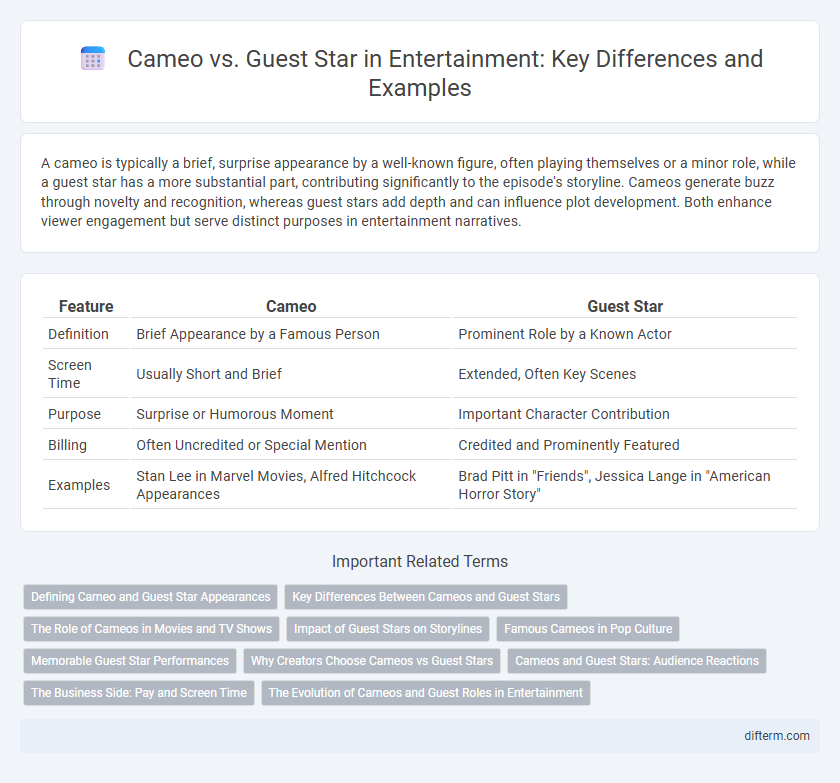A cameo is typically a brief, surprise appearance by a well-known figure, often playing themselves or a minor role, while a guest star has a more substantial part, contributing significantly to the episode's storyline. Cameos generate buzz through novelty and recognition, whereas guest stars add depth and can influence plot development. Both enhance viewer engagement but serve distinct purposes in entertainment narratives.
Table of Comparison
| Feature | Cameo | Guest Star |
|---|---|---|
| Definition | Brief Appearance by a Famous Person | Prominent Role by a Known Actor |
| Screen Time | Usually Short and Brief | Extended, Often Key Scenes |
| Purpose | Surprise or Humorous Moment | Important Character Contribution |
| Billing | Often Uncredited or Special Mention | Credited and Prominently Featured |
| Examples | Stan Lee in Marvel Movies, Alfred Hitchcock Appearances | Brad Pitt in "Friends", Jessica Lange in "American Horror Story" |
Defining Cameo and Guest Star Appearances
A cameo appearance features a brief, often uncredited role by a well-known person, typically adding surprise or humor without impacting the plot significantly. Guest star appearances involve actors playing substantial, credited roles that contribute meaningfully to the storyline in a specific episode or series arc. Both cameo and guest star roles enhance entertainment value by leveraging celebrity presence, but they differ in screen time, narrative importance, and recognition.
Key Differences Between Cameos and Guest Stars
Cameos are brief, often surprise appearances by well-known personalities, typically playing themselves or minor roles, while guest stars have more substantial roles with significant screen time and dialogue. Cameos primarily serve as Easter eggs or fan service, whereas guest stars contribute meaningfully to the storyline or character development. The distinction lies in the depth of involvement and narrative impact within a television show or film.
The Role of Cameos in Movies and TV Shows
Cameos in movies and TV shows serve as brief but impactful appearances by famous personalities, often enhancing viewer engagement and adding a layer of surprise or humor. Unlike guest stars who have substantial roles driving the plot, cameos are typically short, non-recurring, and designed to create a memorable moment or an inside joke for the audience. These fleeting appearances contribute to a richer entertainment experience by connecting fans with familiar faces in unexpected ways.
Impact of Guest Stars on Storylines
Guest stars significantly influence storylines by adding depth and complexity to main plots, often introducing new conflicts or resolutions that shape character development and audience engagement. Their episodic presence allows writers to explore fresh narrative angles without altering core cast dynamics, enhancing the overall storytelling experience. In contrast, cameos typically serve as fleeting moments of recognition, offering minimal impact on the plot's progression or character arcs.
Famous Cameos in Pop Culture
Famous cameos in pop culture often feature well-known celebrities appearing briefly in films or TV shows, creating memorable, surprise moments that delight audiences. Unlike guest stars who have substantial roles or multiple episodes, cameos usually involve a quick, impactful presence by icons such as Stan Lee in Marvel movies or Bill Murray in Wes Anderson films. These brief appearances leverage star power to enhance viewer engagement and deepen the cultural resonance of the entertainment.
Memorable Guest Star Performances
Memorable guest star performances often leave a lasting impact on a show's narrative by delivering substantial character development or pivotal plot points, as seen with stars like Bryan Cranston on "How I Met Your Mother." Cameo appearances tend to be brief and primarily serve as fun, recognizable moments without deeply influencing the storyline. Guest stars typically receive more screen time and dialogue, allowing them to create a more significant and memorable impression compared to fleeting cameo roles.
Why Creators Choose Cameos vs Guest Stars
Creators often choose cameos over guest stars to generate buzz with surprise appearances from popular celebrities without dedicating extensive screen time or plot development. Cameos provide a quick, impactful moment that can delight fans and enhance promotional appeal, while guest stars typically require longer commitments and deeper integration into the storyline. Budget constraints and scheduling flexibility also make cameos a practical choice for boosting a show's visibility without complex narrative commitments.
Cameos and Guest Stars: Audience Reactions
Cameos often generate surprise and excitement, creating buzz through their brief, unexpected appearances that delight fans with a recognizable face. Guest stars typically receive more sustained attention, as their extended roles allow for deeper character development and stronger audience connections. Viewer reactions to both depend on the prominence and relevance of the actor, with cameos sparking quick thrills and guest stars fostering emotional investment.
The Business Side: Pay and Screen Time
Cameo appearances typically involve brief screen time and a one-time payment, often used to create buzz or surprise audiences with a celebrity's unexpected presence. Guest stars usually have more substantial roles, longer screen time, and receive higher compensation reflecting their contribution to multiple episodes or key storylines. The financial arrangements influence casting decisions, with guest stars negotiated through contracts that guarantee specific appearances and remuneration, while cameos are often simpler agreements tied to marketing strategies.
The Evolution of Cameos and Guest Roles in Entertainment
Cameos and guest star roles have evolved dramatically in entertainment, shifting from brief, surprise appearances by iconic figures to more substantial, plot-integrated performances that enhance storytelling depth. Modern cameos often serve as nostalgic nods or marketing tools, while guest stars bring critical character development and audience engagement across television series and films. This evolution reflects changes in audience expectations and the blending of star power with narrative significance in contemporary media.
cameo vs guest star Infographic

 difterm.com
difterm.com